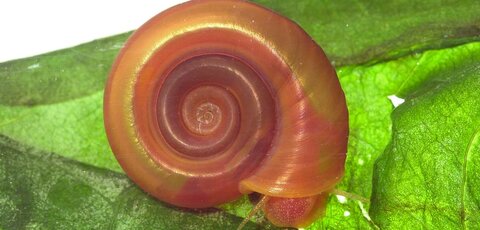Snail genome provides clues to controlling devastating disease

Natural History Museum researchers have helped decode the genome for a snail that transmits the world's second-most deadly parasitic disease. The information could inspire new methods of disease control.
Biomphalaria glabrata is one of a family of freshwater snails that transmits schistosomiasis, a parasitic disease which ranks second only to malaria in terms of its impact on human global health. The disease affects over 250 million people in more than 70 countries around the world, and is a factor in an estimated 200,000 deaths every year.
The new work, published in Nature Communications, was undertaken by an international consortium of researchers from nearly 50 institutions.
Prof David Rollinson, who coordinated the Natural History Museum's contribution to the study, said, 'This is a landmark paper to which many laboratories around the world have contributed.
'The documentation of the full genome sequence of this freshwater snail is extremely important as it will provide exciting opportunities to find new ways to control snails that transmit the debilitating disease.'
A water-borne peril
Also known as bilharzia, schistosomiasis is caused by parasitic flatworms called schistosomes. The parasite has a complex life cycle that involves living in both human and snail hosts.
Humans can be infected if they enter water containing schistosome larvae that have been shed by infected snails. The parasites can cause intestinal or urinary problems, depending on the species of schistosome, and long-term infection can lead to irreversible damage to vital organs.
The disease is prevalent in the tropics and subtropics, especially in poor communities, and makes washing, bathing or swimming in natural water a real risk to the health of people who live in affected areas.
Controlling schistosomiasis
Strategies to control the disease include providing safe sources of fresh water and treating at-risk populations with medicine. However, with the World Health Organisation (WHO) aiming for schistosomiasis to be eliminated as a global health problem by 2025, there is a renewed focus on reducing the numbers of the disease-carrying snails.
The new research will help scientists explore whether the snail's biology can be exploited to stop transmission, either by interfering with the parasite's interaction with its snail host or by finding ways to selectively kill the snail.
Secrets in the snail DNA
As they decoded the snail’s genome, the researchers honed in on various parts of its biology to see more clearly how it functions.
For example, the team identified some of the mechanisms the snail uses to process and eliminate toxins. Scientists could focus on designing new pesticides that only affect the snail and no other wildlife. These could kill the snail or interfere with its reproductive mechanisms, limiting its numbers.
Museum scientists help local experts in Tanzania collect aquatic snail species from lakes and schistosome eggs from the stool of infected humans
Global relatives
As a group, the Biomphalaria freshwater snails are one of the main hosts for a species of schistosome that causes intestinal schistosomiasis in people in Africa as well as the Americas.
Although the snail in this study, Biomphalaria glabrata, lives in South America and parts of the Caribbean, it shares much of its genome with relatives in Africa. Consequently, the research will also be useful in combatting the disease in Africa, where a far greater number of infections occur.
LCNTDR Associate Direction, Prof Rollinson said, 'I am delighted that the Natural History Museum, a WHO-collaborating centre for schistosomiasis, has been part of the UK consortium led by Aberdeen University,'
'We are currently working in many African countries where schistosomiasis is endemic and we fully appreciate the need for new interventions for control and eventual elimination. This latest work is a promising step forward.'
Adapted from an article by NHM’s James McNish, click here to read original article